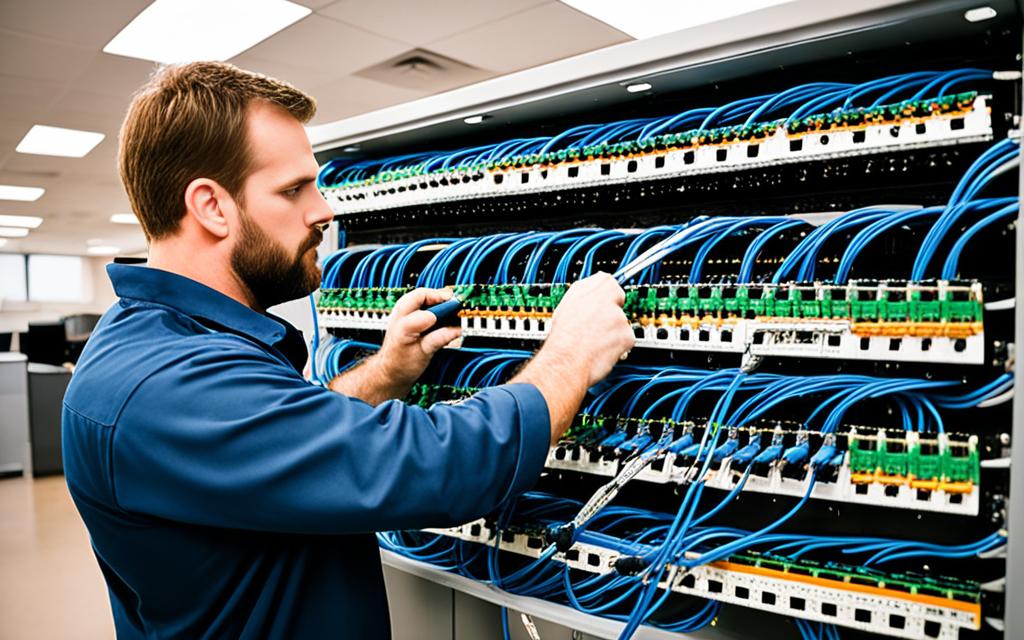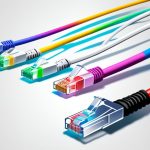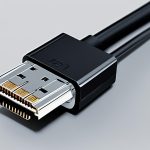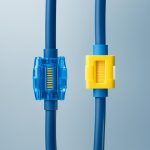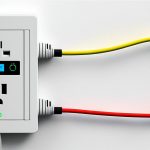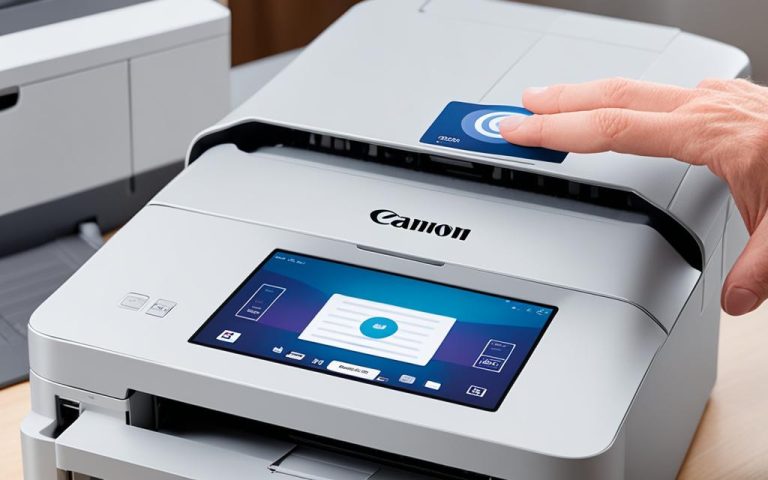Network cabling connects devices, making sure they can talk to each other and share data. It’s key for keeping networks running smoothly and reliably. Knowing about the different cables and how to install them is vital for a strong network.
Key Takeaways:
- Network cabling is essential for connecting devices and enabling communication in an IT infrastructure.
- There are four main types of network cables: coaxial cable, fiber optic cable, shielded twisted pair (STP) cable, and unshielded twisted pair (UTP) cable.
- Coaxial cable is widely used in Ethernet networks, broadband connections, and cable TV systems.
- Fiber optic cable provides high-speed data transmission over long distances and is commonly used in telecommunications networks.
- Shielded twisted pair (STP) cable offers protection against interference and is ideal for business installations.
- Unshielded twisted pair (UTP) cable is extensively used in the telecommunications and computer industries as ethernet cables and telephone wires.
- Proper installation of network cabling is crucial to ensure reliable communication and prevent issues like data loss or downtime.
We’ll look at each type of network cable closely, covering their features, uses, and how to set them up. We’ll also talk about common problems in network cabling and how to fix them.
References:
1 Based on statistical data from “link 1”
2 Based on statistical data from “link 2”
3 Based on statistical data from “link 3”
The Importance of Network Cabling
Network cabling is key to a network’s success. It affects how well the network works, keeps data safe, and boosts business productivity. It sets the stage for reliable and efficient data flow, making everything run smoothly.
One big plus of network cabling is it makes networks work better4. When cables are installed right, they increase bandwidth and improve signal quality. This means data moves faster, helping teams communicate and work together more efficiently.
Network cabling also boosts security4. It helps protect against threats like viruses and hackers, keeping data safe from unauthorized access. This keeps sensitive info secure, making the network safer overall.
It also helps save money4. With the right cabling, businesses don’t need extra gear like repeaters. This cuts costs and makes the network simpler and more efficient.
Another benefit is it makes people more productive4. A fast and reliable network lets employees work better, cutting down on downtime. This leads to a more productive team and better business results.
Network cabling is vital in many areas like businesses, schools, and big companies5. Its use shows its value in today’s connected world. With tech playing a big role in our lives, good cabling is key for smooth operations and clear communication.
Knowing the perks of network cabling is crucial for planning networks. Investing in a good cabling setup means better network performance, more security, lower costs, and more productivity. These benefits highlight why network cabling is a must-have for modern networks.
Types of Network Cables
There are four main types of network cables used in many places6. These are coaxial, fiber optic, shielded twisted pair (STP), and unshielded twisted pair (UTP) cables. Each type has its own features and benefits. They are chosen for different situations and places.
| Type | Description | Main Uses |
|---|---|---|
| Coaxial Cable | Coaxial cable has an inner conductor, insulation, a shield, and an outer layer7. It comes in types like RG-6 and RG-8, each with its own specs7. | Coaxial cables are used for cable TV and Internet services. They work well over long distances with little interference7. |
| Fiber Optic Cable | Fiber optic cables use thin glass or plastic strands to send data as light signals6. They have single-mode and multi-mode types. Single-mode is for long distances with low loss6. Multi-mode is for shorter distances but with more data capacity6. | These cables are perfect for fast, long-distance data transfer. They’re used in telecommunications, internet connections, and data centers6. |
| Shielded Twisted Pair (STP) Cable | STP cable has copper wires with a shield to reduce interference8. It’s categorized as Cat5e, Cat6, and Cat78. | STP cables are great for businesses in areas with a lot of interference. They ensure reliable and fast connections6. |
| Unshielded Twisted Pair (UTP) Cable | UTP cable is like STP but without a shield. It also comes in different categories like Cat5e and Cat6, offering various speeds6. | UTP cables are the most common because they’re affordable and easy to set up. They’re used in Ethernet networks, homes, and small businesses6. |
Each network cable type has its own benefits and uses. Network engineers pick the best one for their network needs6. Knowing about these cables is key to building strong networks.
Learn More About Types of Network Cables:
For more info on network cables and their details, check out these resources:
- Network Cable Types and Specifications
- Network Cable History and Fundamentals
- What Are the 4 Types of Network Cables
Coaxial Cable
Coaxial cable is a versatile type of cable used in many areas. It has a central conductor, an insulating layer, a metallic shield, and an outer jacket. This design makes it useful in different industries.
Uses of Coaxial Cable
Coaxial cable is key in telecommunications, TV broadcasting, and internet connections. Companies use it to send data, video, and voice communications to customers9. It’s chosen for its high bandwidth and moderate cost. It’s also used in CCTV systems, video transmission, and HDTV.
Advantages of Coaxial Cable
Coaxial cable has many benefits. It supports high bandwidth, making it great for sending lots of data and high-quality signals9. It’s easy to install and lasts a long time, making it handy for homes and businesses9. It also fights noise and interference, giving clear communication and top-notch signal quality9.
Characteristics of Coaxial Cable
Coaxial cable’s design affects its performance. It comes in 50 ohms or 75 ohms impedance10. The right impedance depends on the setup and needs. For example, 75 ohms is often used for home setups, while 50 ohms is better for higher power uses10.
Coaxial cables vary in construction, impacting their size, frequency range, and more11. Some cables are better in humid places, while others handle high power or high frequencies11. The jacket can be made from different materials, like PVC, for specific needs11. Some cables have a water-blocking gel to keep out moisture11.
Connector Types and Standards
Coaxial cables use different connectors for various needs. You’ll find BNC, TNC, SMA, RCA, and F connectors9. These connectors help keep the signal strong and clear. Coaxial cables follow about 50 standards, with RG-6 being a common one for its shields and 75 ohms impedance10.
Coaxial cable is a dependable and flexible option for many uses. It offers high bandwidth, easy setup, durability, and noise resistance9. It might be a bit bulky and can be vulnerable to security issues9. Yet, it’s a key part of many global telecommunications, broadcasting, and internet systems.
Fiber Optic Cable
Fiber optic cable is a modern and advanced type of network cable. It changed how we send information by using light instead of electrical signals. This cable has a core made of glass or plastic, covered by protective layers.
Fiber optic cables have many benefits over old cables. They can send data faster and carry more information. This means data moves at very high speeds, perfect for today’s data-heavy needs. They also don’t get affected by electromagnetic interference, which can mess up signals.
Another big plus is how far they can send information without losing signal. Unlike copper cables, fiber optic cables can go for kilometers without needing boosters. This makes them great for long-distance data transfer and building the internet backbone.
When it comes to durability, fiber optic cables are top-notch. They don’t corrode, so they work well for a long time. They also handle fire damage better, making them safer for places where fire safety is key.
Let’s look at some stats to see how fiber optic cables are used and their benefits:
| Statistic | Reference |
|---|---|
| The highest strand-count single-mode fiber cable commonly manufactured is the 864-count, consisting of 36 ribbons each containing 24 strands of fiber. | 12 |
| In September 2012, NTT Japan demonstrated a single fiber cable able to transfer 1 petabit per second (1015bits/s) over a distance of 50 kilometers. | 12 |
| Telcordia GR-20 contains reliability and quality criteria for optical fibers in all operating conditions, focusing on conditions in an outside plant environment. | 12 |
| Common jacket materials for fiber optic cables include LSZH, polyvinyl chloride, polyethylene, polyurethane, polybutylene terephthalate, and polyamide, with specific properties determining their use. | 12 |
| Fiber materials used in optical fibers are primarily glass and plastic, with glass fibers used for telecommunications due to their characteristics suited for long-range applications. | 12 |
| Color coding is employed in fiber optics for patch cords, connector boots, and cord jackets to indicate the type of fiber used, with different colors serving different purposes. | 12 |
| The EIA/TIA-598 standard defines identification schemes for fibers and buffered fibers in multi-fiber cables for optimal cable management and maintenance. | 12 |
| Single-mode fiber cables have up to 5 times smaller diametral core than multimode cables. | 13 |
| Multimode fiber optics provide high bandwidth at high speeds over medium distances (up to 1km) at a lower cost. | 13 |
| Single-mode fiber optics offer unlimited bandwidth at very high speeds over long distances (up to 80km) at a higher cost. | 13 |
| Typical light wavelengths used in multimode fiber optics are 850 nm and 1300 nm. | 13 |
| Typical light wavelengths used in single-mode fiber optics are 1310 nm and 1550 nm. | 13 |
| Single-mode cables are coated with a yellow outer sheath, while multimode cables are coated with orange or aqua jackets. | 13 |
| Key factors for choosing between single-mode and multimode include distance requirements, costs, and upgradability. | 13 |
| A typical Ethernet link with fiber requires two fiber cables, one for each direction, and two transceiver modules such as SFP or SFP+. | 13 |
| Fiber optic cables support much of the world’s internet, cable television, and telephone systems. | 14 |
| Fiber cables rated at 10 Gbps, 40 Gbps, and 100 Gbps are standard for carrying network bandwidth. | 14 |
| Cable technology supports approximately 1,000 Mbps of bandwidth, while fiber optic internet supports speeds of up to 2,000 Mbps. | 14 |
| At 1,000 Mbps, a 2-hour HD movie can be downloaded in about 32 seconds; at 2,000 Mbps, it takes approximately 17 seconds. | 14 |
| Providers like Verizon FIOS and Google Fiber offer gigabit internet speeds to households with fiber-to-the-home services. | 14 |
| Different fiber optic installation packages include FTTP (Fiber to the Premises), FTTB (Fiber to the Building/Business/Block), FTTC/N (Fiber to the Curb of Node), direct fiber, and shared fiber. | 14 |
| Fiber optic internet is faster and more reliable than traditional internet cables since it doesn’t involve electricity. | 14 |
Fiber optic cables have many uses and bring big benefits to networks. They support fast data transfer over long distances and resist interference. This makes them key for telecommunications and the internet backbone. Fiber optic cables also give households faster and more reliable internet, changing how we use online services.
Shielded Twisted Pair (STP) Cable
Shielded twisted pair (STP) cable is a dependable and versatile network cable. It has an outer shield to protect against electromagnetic and radio frequency interference15.
STP cables are used in phone systems and computer networks. They help reduce interference from power lines and other sources. This ensures data transmission without interruptions15.
In noisy business settings like data centers and industrial areas, STP cables are a go-to choice. They work with different connectors like RS-449, RJ-45, RS-232, and RJ-11. This makes them versatile for various setups15.
STP cables offer better protection against interference than unshielded twisted pair (UTP) cables. But, they are pricier and need more expertise to install than UTP cables15.
STP cables have different categories, each with its own bandwidth and data transfer rates. Categories include Cat5e, Cat6, Cat6a, and Cat7. These cables support high data rates and reliable performance for different networking needs1516.
STP cables prevent electrical noise and reduce crosstalk between wires. They are easy to handle and install. The shielding ensures a stable and reliable network connection in challenging environments17.
But, STP cables have some downsides. They can be deformed, causing interference and affecting performance. Also, delays in data transmission can happen, impacting network efficiency. Proper installation and management are key to avoid these issues17.
In summary, STP cable is a solid choice for network setups where interference is a problem. It offers enhanced signal quality, reduced interference, and high-performance networking. This makes it ideal for industrial settings, data centers, and noisy environments1517.
| Advantages of STP Cable | Disadvantages of STP Cable |
|---|---|
|
|
Unshielded Twisted Pair (UTP) Cable
UTP cable is key in today’s networks, offering dependable and cost-effective connections. It’s used in many places, making it vital for our digital lives.
UTP cable uses twisted pairs of wires. This design cuts down on interference, making signals clear and reliable. It’s popular for its low cost and easy setup, making it perfect for phone lines and computer networks.
UTP cable is great for local and wide area networks. It’s needed for sending data over long distances reliably. It supports different speeds like Cat5e, Cat6, and Cat6a, each with its own top speed.
| Cable Category | Maximum Transfer Rate | Maximum Distance |
|---|---|---|
| Cat5e UTP Cable | 1 Gbps | 100 meters18 |
| Cat6 UTP Cable | 10 Gbps | 100 meters18 |
| Cat6a UTP Cable | 10 Gbps | 100 meters18 |
UTP cable does more than just fast data transfer. It’s used for voice calls, slow data, audio, and more. This makes it crucial in many industries.
UTP cables come in different types, each with its own specs. Categories like Cat5e, Cat6, and Cat6a meet specific needs. They use a color code for easy identification.
UTP cables are plugged in with RJ45 jacks that match the cable type. There are two wiring standards, T568A and T568B, for assigning pins. This ensures everything connects right.
UTP cable is also used in power over Ethernet (PoE) systems, sending power and data together. It’s great for high-definition surveillance systems too, with video baluns or converters.
In summary, UTP cable is a top choice for networks because it’s affordable, easy to install, and reliable. It supports fast data transfer and is key in many systems. Its versatility and performance make it essential in our digital world.
Planning and Installation of Network Cabling
Getting the planning network cabling right is key for a smooth network cabling installation. You need to look at what the network needs, design the cabling, figure out cable lengths, and get the site ready.
For a top-notch network cabling installation, make sure cables are routed well to avoid problems and keep signals strong19. It’s also vital to secure cables properly to keep connections strong and signal loss low. Testing and certifying the cabling system is a must to check it works well19.
When planning network cabling, think about safety to prevent accidents and damage. Following safety rules and guidelines makes sure the job is done safely and well20.
For the network cabling installation, it’s smart to work with a pro and certified Network Cabling company. They have the skills and know-how to make sure the wiring and connections are up to standard20.
Think about how your system might grow and what tech changes might come. Pick network cabling that can handle fast speeds and lots of data. For example, Cat6 cables are good for today’s networks, while Cat8 cables are ready for the future with speeds up to 40Gbps19.
For long distances, use single-mode fiber optic cables. They send data far and keep it safe from interference19. For shorter distances in buildings, multi-mode fiber optic cables are better19.
In short, careful planning is key for planning network cabling and a successful network cabling installation. This means looking at what the network needs, designing the cabling, figuring out cable lengths, and getting the site ready. Following best practices like good cable routing, secure connections, thorough testing, and safety is important. Working with a pro Network Cabling company helps ensure your wiring and connections are top-notch. Choosing the right cabling, like Cat6 or Cat8, and the right fiber optic cables for distance, is crucial for a system that can grow with technology1920.
Common Challenges and Solutions
Network cabling installation has its own set of challenges. It’s important to know these challenges and have good solutions ready. This way, you can make sure your network works well and doesn’t have downtime. We’ll look at some common problems and how to fix them.
Bandwidth Shortage
Bandwidth shortage is a big issue in network cabling. Not having enough bandwidth means slower speeds, more network congestion, and less efficiency. If cables aren’t planned right, it gets harder to maintain the network and can cause problems21.
Tangled Cables
Tangled cables are another big problem. If cables are not managed well, they can affect signal quality and network performance21. Using cable trays and organizing cables properly can stop cables from tangling. This keeps your network running smoothly.
Electrical Interference
Putting network cables near electrical wires can mess with signal transmission because of electromagnetic interference. This can cause network problems and slow things down21. To avoid this, keep network cables away from electrical wires. This helps keep the signal strong and clear.
Incorrect Placement
Putting cables in the wrong place is another challenge. If cables are not placed right, they can cause interference or problems21. Planning carefully and following cable placement standards can solve these issues. This makes your network work better and easier to maintain.
Installation Damage
It’s important to handle network cables carefully during installation. Using wire ties too tightly can damage cables, leading to signal loss21. To prevent damage, make sure installers are well-trained and follow the right practices for handling cables.
By tackling these common challenges, you can make network cabling installation go smoothly. This ensures your network works well and has less downtime. Using the right solutions helps build a strong and reliable network for today’s digital needs.
For more info on common network cabling challenges and solutions, check out these sources:
- Common Network Cable Problems and Their
- 11 Common Problems with Your Cabling
- Common Network Cabling Mistakes and Solutions
Conclusion
Network cabling is key to a smooth-running IT setup. It’s essential to invest in quality cabling to boost network speed and cut down on downtime22. Bad cables can weaken signals, making your network slow and less efficient22. It’s also important to follow the rules set by local and federal laws for cabling22.
By choosing the right cabling, companies can lower network failures and get more work done22. Bad cables can cause signal problems, leading to data loss or security issues22.
There are different types of network cabling, like Cat5e, Cat6, Cat6a, and Cat7 cables, each with its own speed and capacity23. Fiber optic cables are faster and have less signal loss, making them great for long distances24. They’re also not affected by electrical noise and can send signals for miles2324.
Setting up network cabling needs careful planning and the right installation methods2324. Keeping an eye on the cables and making sure they’re working well is key2324. Knowing about cabling helps businesses make smart choices and build a strong communication system24. With the right cabling, companies can have a dependable and fast network that meets their tech needs222324.
FAQ
What is network cabling?
Network cabling connects computers and devices, letting them talk and share info.
How many types of network cables are there?
There are four main types: coaxial, fiber optic, shielded twisted pair (STP), and unshielded twisted pair (UTP) cables.
What are the advantages of proper network cabling?
It boosts network speed and signal quality. It also makes networks more secure, cuts costs, and boosts productivity.
What is coaxial cable used for?
Coaxial cable is used in older buildings for reliable data transfer over short distances. It’s used for Ethernet networks, broadband internet, and cable TV.
What are the advantages of fiber optic cable?
Fiber optic cable offers fast data transfer, high bandwidth, and immunity to interference. It also works over long distances and resists corrosion and fire.
Where is shielded twisted pair (STP) cable commonly used?
STP cable is used in phone systems and computer networks to prevent interference from power lines and other sources.
What is unshielded twisted pair (UTP) cable used for?
UTP cable is used for phone lines and computer networks. It’s great for long-distance data transfer in LANs and WANs.
What are the best practices for network cabling installation?
Best practices include routing cables well, securing connections, testing, and following safety rules.
What are the common challenges in network cabling installation?
Challenges include bandwidth issues, tangled cables, poor labeling, old cables, interference, and damage during installation.
How important is network cabling in an IT infrastructure?
Network cabling is key to IT infrastructure, enabling devices to communicate and share info. It’s vital for network performance, security, cost savings, and productivity.
Source Links
- https://fcit.usf.edu/network/chap4/chap4.htm – Chapter 4: Cabling
- https://networkdrops.com/blog/the-different-types-of-network-cabling/ – The Four Types of Network Cabling | Network Drops
- https://www.newyorkcables.com/updates/common-types-of-network-cabling-for-businesses/ – Common Types Of Network Cabling For Businesses
- https://www.cynergytech.com/stories/what-is-network-cabling-why-is-it-important/ – Network Cabling | What Is It & Why Is It Important?
- https://www.bridgecable.com/why-is-network-cabling-important/ – Why Is Network Cabling Important? | Bridgecable.com
- https://www.tevelec.com/what-are-the-4-types-of-network-cables/ – What Are the 4 Types of Network Cables? – Tevelec
- https://www.computernetworkingnotes.com/networking-tutorials/network-cable-types-and-specifications.html – Network Cable Types and Specifications
- https://www.techtarget.com/searchnetworking/tutorial/Network-cable-history-and-fundamentals-Cabling-tips-for-network-professionals-lesson-1 – What are the different types of network cables? | TechTarget
- https://www.geeksforgeeks.org/what-is-coaxial-cable/ – What is Coaxial Cable ? – GeeksforGeeks
- https://www.techtarget.com/searchnetworking/definition/coaxial-cable-illustrated – What is a coaxial cable? A definition from WhatIs.com
- https://en.wikipedia.org/wiki/Coaxial_cable – Coaxial cable
- https://en.wikipedia.org/wiki/Fiber-optic_cable – Fiber-optic cable
- https://www.networkacademy.io/ccna/ethernet/fiber-optic-cabling – Fiber-Optic Cabling
- https://www.lifewire.com/fiber-optic-cable-817874 – The Role of Fiber Optic Cables in Computer Networking
- https://www.techtarget.com/searchnetworking/definition/shielded-twisted-pair – What is shielded twisted pair and does it work?
- https://www.cbtnuggets.com/blog/technology/networking/utp-vs-stp – UTP vs. STP: Understanding the Differences in Ethernet Cable Types
- https://www.geeksforgeeks.org/what-is-stpshielded-twisted-pair/ – What is STP(Shielded Twisted Pair)? – GeeksforGeeks
- https://www.lenovo.com/us/en/glossary/utp/ – Unshielded Twisted Pair Cable Explained
- https://www.bcsconsultants.com/blog/a-comprehensive-guide-to-network-cabling-installation/ – Comprehensive Guide to Network Cabling Installation
- https://www.cablify.ca/planning-for-network-cabling/ – Planning for Network Cabling? – Cablify
- https://www.bridgecable.com/common-network-cable-problems-their-solutions/ – 5 Most Common Network Problems & Their Solutions
- https://www.sentryprotectsyou.com/blog/why-network-cabling-is-essential-for-business-success/ – Why Network Cabling Is Essential For Business Success | Sentry Communications & Security
- https://amorserv.com/insights/what-is-network-cabling-why-is-it-important – What Is Network Cabling & Why Is It Important?
- https://www.linkedin.com/pulse/why-network-cabling-important-airspot-networks – Why is Network Cabling Important?

